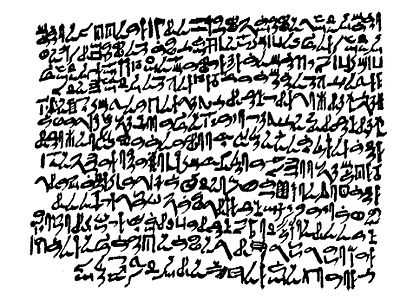Prisse Papyrus

The Prisse Papyrus, dating from the twelfth dynasty Egyptian Middle Kingdom,[1] was obtained by the French orientalist Émile Prisse d'Avennes at Thebes in 1856 and is now in the Bibliothèque nationale de France in Paris.
The papyrus document contains the last two pages of the Instructions of Kagemni, who purportedly served under the 4th Dynasty king Snefru, and is a compilation of moral maxims and admonitions on the practice of virtue. The conclusion of the Instructions of Kagemni is followed by the only complete surviving copy of the Instruction of Ptahhotep.[2][3][4][5]
See also
References
- ↑ I. E. S. Edwards, N. G. L. Hammond, C. J. Gadd, The Cambridge Ancient History, Cambridge University Press 1975, p.159
- ↑ M. Lichtheim, Ancient Egyptian Literature, Volume I, 1973, p.59
- ↑ Z.Zába (1956) retrieved 11:20GMT 24/9/11
- ↑ papyrus "Prisse" JW Bone (1887)
- ↑ Battiscombe G. Gunn, "THE WISDOM OF THE EAST, THE INSTRUCTION OF PTAH-HOTEP AND THE INSTRUCTION OF KE'GEMNI: THE OLDEST BOOKS IN THE WORLD", LONDON, JOHN MURRAY, ALBEMARLE STREET, 1906, https://www.gutenberg.org/files/30508/30508-h/30508-h.htm
Literature
- The Instruction addressed to Kagemni in M. Lichtheim, Ancient Egyptian Literature, Volume I, 1973, pp.59ff.
- The Instruction of Ptahhotep in M. Lichtheim, Ancient Egyptian Literature, Volume I, 1973, pp. 61ff.
- "Papyrus Prisse" by Franz. Joseph Lauth retrieved 10:53 24/9/11
- papyrus "Prisse" JW Bone (1887) retrieved 11:34GMT 24/9/11
- text written-Isaac Meyer retrieved 13:36GMT 25.9.11
External links
- Teaching of Ptahhotep, University College London